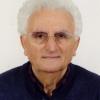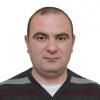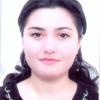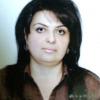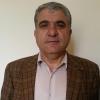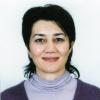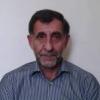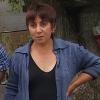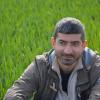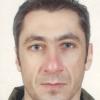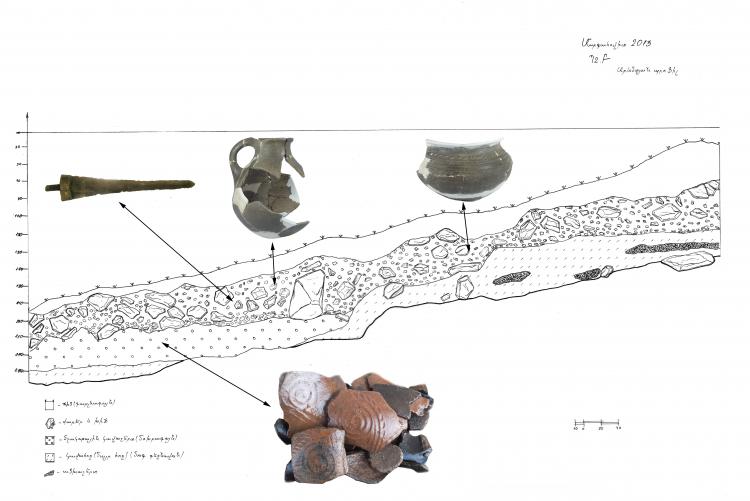
1. History
The Margahovit settlement is located in Margahovit (formerly Hamzachiman), in Lori Region, 17 km from Vanadzor, in the middle part of Vanadzor-Dilijan highway. The monument is located on the western side of the village, on the natural and sting-shaped hillside called Sari Sop, near the source of Aghstev River. The hill occupies a total area of 7.8 hectares, of which 1.2 hectares occupies a hilltop fenced section.
Margrahov's monument is mentioned for the first time. By Khanzadyan in 1967 in his important work dedicated to the Kura-Araxian culture. Later, for a long time, the monument was forgotten and is remembered by separate archeologists and geologists. The interest in the Margahovit village is revived especially since the early 2000s when A. Gevorgyan and A. Palmier visited the monument, who were carrying out excavations in the adjacent Fioletovo monument.
No excavations have been carried out in the settlement and in the village. In order to start a serious archaeological work in Margahovit in 2010 our group visited the monument and performed preliminary reconnaissance studies in the area (ceramic debris collection, location survey).
2. Activity
2011-2017 (excluding 2015) the expedition of the Institute of Archeology and Ethnography of NAS RA has conducted excavations in Margahovit settlement. In thirteen trenches there were excavations, two of which were on the centeral- east of the hill (A, B, Kh), two south-eastern (D, Eu), two central-western (G, E), four central-northern (Z, Ee, I, J) One in the north-northeast (Tt) and one in the south-western (K) section 4 x 4 m (A, B, D, L), 4 x 6 m (Tt), 8 x 8 m (G), 5 x 8 m (E, Z, Ee), 8 x 10 m (Eu), 4 x 10 m (I, J) and 4 x 12 m (K). The excavations were carried out in 2011: A, B, C, D, 2012 - G, E, Z, 2013, B, G, Z, 2014, Tt, 2016, and in 2017, at L, K. A total area of 484 square meters has been excavated.
As a result of excavations today it is possible to speak about the existence of a four-staged settlement in Margahovit. The first three of them (early bronze, middle bronze, late bronze / early iron) are documented in layers, and the fourth is visible on the surface or as a further violation of cultural layers (medieval, new era).
- Stage I - Early Bronze is the main stage of the settlement, with over 90% stratigraphic situations and finds. Nearly 95% of the ceramics known from all the excavations are Kura-Arax types. However, if A, C, E, Z, Eu, J, I, L, K excavated trenches still do not clarify the existence of sub-horizons; then by D trench it was possible to differentiate between two clay-floorings and in B and Ee, two different chronological layers, which we call IA and IB horizons.
- Stage II- Middle bronze. The 2012 excavations have revealed a new phenomenon, Martkopyan ceramics, in the same context as the Kur-Araks ceramics (Trenches Z, M 5, 7), which refers to the fact that Margahovit has some potential for exploring the early Bronze-Bronze transitional phase, but there are still no clear contexts that allow us to discuss this phenomenon. Additionally, more serious data were obtained to mark the last stage of the Middle Bronze in Margahovit (structure of trenches E, M 4).
- Stage III - Late Bronze / Early Iron, presented in the A, G, E, Z, Ee, Tt, K trenches, especially in the A and G destinations, where there are contradictory contexts concerning this era. In addition, late Bronze / the castle fence is from Early Iron Age.
- Stage IV - Medieval and New Age, represented by medieval ceramics (E, Z, Ee, K). In addition, the rectangular structure of the central part of the hill and the cross-stones of the north-eastern part are evidences for the advanced Middle Ages (IVa), and the Muslim graves for the late medieval and tracks of new periods (IVb).
Margahovit habitat, being in a metal-mine zone, should play an important role in metallurgical developments.
The preliminary results of the work have been published here:
Gevorgyan A., Bobokhyan A., Vanyan H., Danielyan H., Archeological Works in Margahovit, Metsamorian Readings 1, Historical Cultural Preservation Museum and Historical Environment Protection Service SNCO, Piliposyan A. (ed.), Yerevan, 2017, pp. 6-24.
3. Staff
Margahovit's archaeological work is supervised by A. Gevorgyan, the employees are A. Bobokhyan, H. Vanyan, H. Danielyan. The expedition cooperates with the Archaeobotanist R. Hovsepyan, Antropologist H. Simonyan, Archaeozoologist A. Genjyan. Institute staff members participated in archeological excavations. A. Petrosyan and R. Davtyan as well as D. Twomlow and individuals from the Wessex University.
Picture List
1. Margahovit goggles, 2011
2. YSU students during excavations, 2012
3. Expedition members after the excavations in 2013.
4. General picture of the Iron Age strengthening system (Trench G), 2014.
5. The strengthening system (Trench G) Stratigraphy (lower layer, early Bronze; Upper, Iron Age), 2013.
Translated from Armenian by Noushig Zarikian






